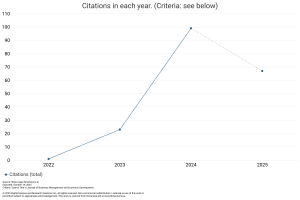Critical Analysis of the Role of Management Information Systems in Optimizing Strategic Decision Making
DOI:
https://doi.org/10.59653/jbmed.v2i02.854Keywords:
Management Information Systems (SIM), Strategic Decision Making, Information Technology Integration, Operational Efficiency, Organizational PerformanceAbstract
This journal provides a critical analysis of the role of management information systems (SIM) in optimizing strategic decision making in the current business environment. By exploring related literature and relevant case studies, the authors highlight the importance of SIM integration in the strategic decision-making process. This article highlights the challenges organizations face in effectively implementing SIM as well as the opportunities that exist to improve performance through the use of advanced information technology. This analysis not only provides deep insight into the contribution of SIM to strategic decision making, but also identifies areas where improvements can be made to increase the efficiency and effectiveness of the system. In conclusion, this article emphasizes the importance of SIM as a strategic tool that not only facilitates better decision making, but also provides a competitive advantage to organizations in today's digital era.
Downloads
References
Alter, S. (2013). Decision Support Systems: Current Practice and Continuing Challenges. Addison-Wesley.
Bhatt, G. D. (2001). Knowledge Management in Organizations: Examining the Interaction Between Technologies, Techniques, and People. Journal of Knowledge Management.
Choo, C. W. (1996). The Knowing Organization: How Organizations Use Information to Construct Meaning, Create Knowledge, and Make Decisions. International Journal of Information Management.
Davis, F. D. (1989). Perceived Usefulness, Perceived Ease of Use, and User Acceptance of Information Technology. SIM Quarterly.
DeLone, W. H., & McLean, E. R. (2003). The DeLone and McLean Model of Information Systems Success: A Ten-Year Update. Journal of Management Information Systems.
Fazil, A. W., Hakimi, M., Aslamzai, S., & Quch, M. M. (2024). A Review of E-Government Practices in the Age of Digitalization. International Journal of Multidisciplinary Approach Research and Science, 2(02), 511–527. https://doi.org/10.59653/ijmars.v2i02.568
Grover, V., & Davenport, T. H. (2001). General Perspectives on Knowledge Management: Fostering a Research Agenda. Journal of Management Information Systems.
Hevner, A. R., & Chatterjee, S. (2010). Design Research in Information Systems: Theory and Practice. Springer.
Krisprimandoyo, D. A. (2023). Optimizing Corporate Branding: The Role of Artificial Intelligence In Business Transformation of IQOS. Jurnal Riset Multidisiplin Dan Inovasi Teknologi, 2(01), 283–306. https://doi.org/10.59653/jimat.v2i01.482
Lucas Jr, H. C., & Spitler, V. K. (1999). Technology Use and Performance: A Field Study of Broker Workstations. Decision Sciences.
Laudon, K. C., & Laudon, J. P. (2016). Management Information Systems: Managing the Digital Firm. Pearson.
McLeod, R., & Schell, G. (2014). Management Information Systems. Pearson.
Markus, M. L., & Robey, D. (1988). Information Technology and Organizational Change: Causal Structure in Theory and Research. Management Science.
Nurninawati, E., Soedaryono, C. K. T., & Hamzah, M. (2023). Campaign Management System with Big Data Analytics in Marketing Products through Digital Channel. International Journal of Multidisciplinary Approach Research and Science, 1(03), 266–276. https://doi.org/10.59653/ijmars.v1i03.103
Power, D. J. (2002). Decision Support Systems: Concepts and Resources for Managers. Quorum Books.
Saputra, T., & Setiawan, E. (2023). Information Security System Using Blockchain Technology Implementation. Jurnal Riset Multidisiplin Dan Inovasi Teknologi, 1(01), 26–30. https://doi.org/10.59653/jimat.v1i01.162
Scott Morton, M. S. (1991). The Corporation of the 1990s: Information Technology and Organizational Transformation. Oxford University Press.
Sulistyowati, T., & Husda, N. E. (2023). A Global Outlook on Sustainable Plant Acquisition: A Review of Scholarly Works. International Journal of Multidisciplinary Approach Research and Science, 1(03), 536–548. https://doi.org/10.59653/ijmars.v1i03.286
Turban, E., Sharda, R., & Delen, D. (2019). Decision Support and Business Intelligence Systems. Pearson
Wahyudin, A., Bani, F. C. D., & Ibrahim, A. B. (2023). Development of Big Data Analytics Technology on Sea Freight Operational Performance Using the Agile Model. International Journal of Multidisciplinary Approach Research and Science, 2(01), 216–228. https://doi.org/10.59653/ijmars.v2i01.398
Watson, H. J., & Wixom, B. H. (2007). The Current State of Business Intelligence. IEEE Computer Society.
Downloads
Published
How to Cite
Issue
Section
License
Copyright (c) 2024 Ade Apriyanto Daud, Siti Marwa Yasani, Adelia Bohar, Refka Latif, Habib Abdul

This work is licensed under a Creative Commons Attribution-ShareAlike 4.0 International License.
Authors who publish with this journal agree to the following terms:
- Authors retain copyright and grant the journal right of first publication with the work simultaneously licensed under a Creative Commons Attribution-ShareAlike that allows others to share the work with an acknowledgement of the work's authorship and initial publication in this journal.
- Authors are able to enter into separate, additional contractual arrangements for the non-exclusive distribution of the journal's published version of the work (e.g., post it to an institutional repository or publish it in a book), with an acknowledgement of its initial publication in this journal.
- Authors are permitted and encouraged to post their work online (e.g., in institutional repositories or on their website) prior to and during the submission process, as it can lead to productive exchanges, as well as earlier and greater citation of published work (See The Effect of Open Access).





























